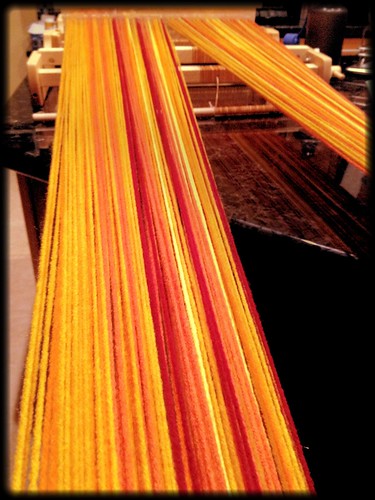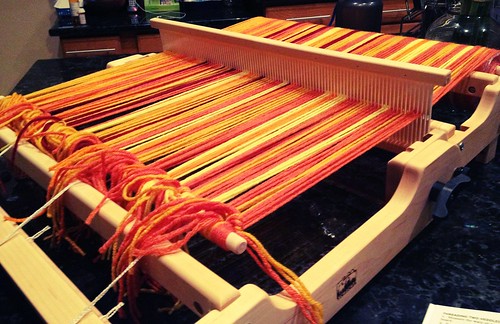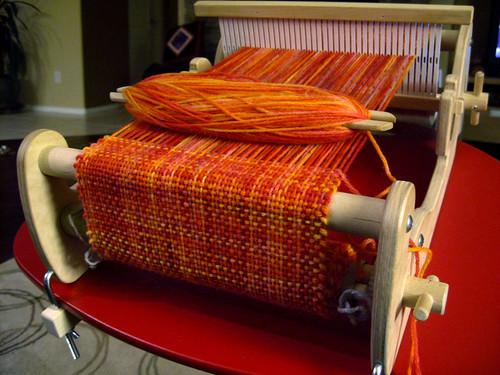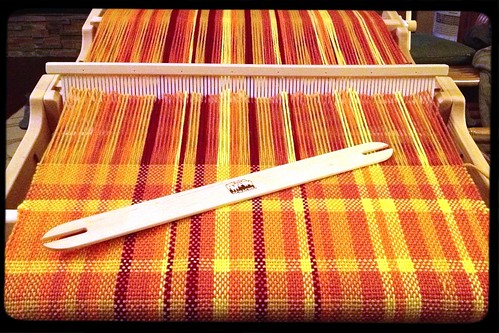Looming Large
Well hello there…this semi-regular blogging thing is proving to be a bit more challenging than anticipated! It’s making me recall just how my old blog fell into neglect in favor of the ever quick and easy 140-character (or so) social media updates 🙂 never the less, I will strive to forge onward 😀
Look who’s joined the family! I’ve got myself a larger brother to my wee cricket…Meet the Flip! He’s got a 20-inch weaving width and a double heddle weaving block…throw in a pickup stick and I should be able to weave some more challenging patterns 🙂
Somewhat surprisingly, the two looms appear to be warped with similar yarn – the project above on the cricket is actually a scarf that I wove from some of the first yarn I ever dyed (out of kool-aid packets no less) – the flip is warped with more Sabbatical Yarn that was remaining after my holiday ornament fiesta.

Setup for the flip is easy and straightforward – out of the box, all I had to do was attach the apron rods and it was ready to warp. I warped the flip the same way I warp my cricket, which is to say I direct warp it using a warping peg. Now that I have two warping pegs on hand (I really need to get a raddle), I split the warp into two sections to try to keep the warp as even as possible. Turns out getting the warp onto the loom was the easy part…the more challenging bit was sleying the reed. Reaching across the 20-plus inch width of the loom to get the alternating strands of warp through the holes on the heddle proved to be somewhat of an ergonomic challenge. I’m going to have to read up and see if anyone has suggestions. It seemed easiest to sley the reed by standing to one side of the loom and working my way across – working from the front of the loom simply wasn’t terribly comfortable, and because I am right-hand dominant, standing to the right of the loom was not working terribly well – so I did all of the work standing on the left hand side of the loom next to the heddle block. Getting all the warp yarns happily through the heddle may have been extra challenging because I was using a reed sized for finer yarn – I selected that reed on purpose because this finished weaving will actually be a rug to run the entire width of my sliding glass door (so I’m aiming for denser fabric).
In case you’re wondering, the warp was put on in a somewhat random fashion – I estimated the length of the warp taking into account fringe and loom waste (about 6-12 inches of total waste once the the fringe was accounted for) and just kept in mind the approximate ratios of the colors of yarn that I had remaining. I was aiming for a random plaid-like finished project – if I wanted something more regular, I would have taken the time to do the required math, but in this case, I was just itching to get going on the project.
Here we are with one shuttles worth of yarn completed in plain weave – I’d say it’s working up quite nicely, wouldn’t you? During the course of this weaving, I was struggling on occasion with skipped warp yarns, if you look closely at the above photo, you might spot such an incident. Turns out I was having some user error problems and had not stumbled upon a way to keep the heddle locked in a down position. After finishing the project I found some very handy photos on Ravelry demonstrating the heddle in its locked down-shed position.
In case you are wondering, the weft was randomly wound onto the shuttle – I cut the yarn at the edges rather than carrying multiple colors up the sides – I have no idea if this is going to cause fraying down the line, as this is the first weaving project I’ve completed with intentional color/yarn changes. So far, so good – the weaving is progressing smoothly with only a few hiccups! (note to self: secure some wider warp “paper”)


